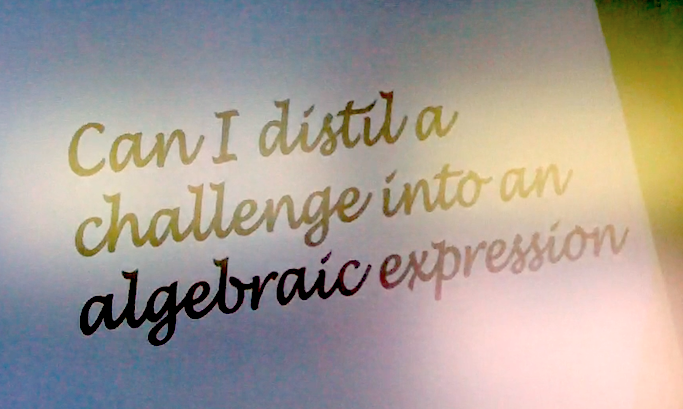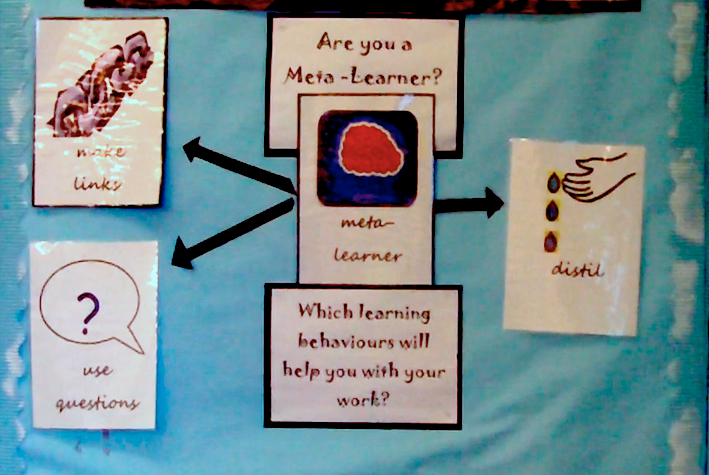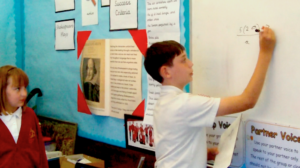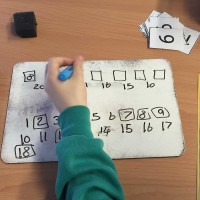Last week we took a peek at junior children from St Herbert’s C of E primary school in Keswick talking confidently about their learning power. This week we take a closer look at what’s going on in a learning powered maths lesson in Year 6. Take a look at how the story of the lesson unfolds.
Year 6 have been working on a unit of algebra and their teacher Ms Mann now thinks the children are ready to explore their understanding by trying to solve challenges. The story arc of the lesson goes as follows:
- Introduction, setting out the main challenge and linking this to the learning behaviours to be used
- Grapple challenge, talk partners having a go at a challenge…a sort of try out
- Demonstrating how, students invited to demonstrate, to the class, how they came to the solution
- Selecting challenges, a range of challenges introduced, for selection by the students
- Teacher coaching, visiting talk partners and coaching the students on working through the challenges
- Reflecting on the session, drawing things to a close with the class reflecting on the learning achieved and the learning powers used.
So far so common. What’s new here you might say? It’s not so much in the structure but in how the details of this play out across the 45 mins. You might watch out for how Ms Mann, the teacher; talks about learning; what she is saying when she coaches the students; how she requires the students to think for themselves; how and what she praises as she visits each group. It’s in these almost hidden, private moments with the children that Ms Mann works her learning power magic.
Introduction
1. The challenge for the whole lesson appears on the whiteboard. It’s an objective that’s written in an engaging way. No… ‘be able to….’ just a personal invitation to see if you can…

2. The challenge is accompanied by a reminder of which learning behaviours need to be in particular play today
The particular learning powers in play are shown on an easily amended display at the front of the classroom:
- Making links... back to their previous learning in algebra
- Distilling down to the most important aspects of the challenges, separating the critical aspects that shape the algebraic solution from the background, contextual information
- Questioning – the sort of questions the students need to ask themselves to get them to a successful answer.
You might well say “What about reasoning?” since this is after all a maths lesson. Well of course the reasoning behaviour will be used but here the emphasis is on meta-cognitive behaviours.
Of course all your lessons have a dual purpose even though you may not realise it: the content dimension, with material to be mastered; the ‘epistemic’ dimension, with some learning skills and habits being exercised. The point about this learning power approach is that teachers make conscious choices about which habits to introduce and stretch and how best to couple these with content so that lessons become more interesting and challenging. Through such overt coupling of content and specific types of process, students come to know, understand and take control of their learning behaviours – they knowingly begin to use and develop the whole range of learning behaviours. Read on for a closer look at how.

Grapple challenge
3. The students learn with their talk partners as they wrestle with the initial challenge
Despite a small and cramped classroom every talk partner pair immediately had fun trying to work things out. They are clearly at ease with this way of working. Notice here how the children react when, by checking their working out with each other, they realise that it has worked!
4. Ms Mann visits each talk partnership to see how things are going
Ms Mann is taking the role of learning coach. She knows that when children are curious they are genuinely interested in learning. So curiosity lies at the heart of her coaching. She listens carefully and asks questions to open dialogue without it sounding like an interrogation. This helps the children to see what they are doing more clearly and discover their own ways to improve.
Above all, she resists offering solutions. Offering solutions does little to secure learning as the student hasn’t been allowed to confront and engage with the problem and find their own way forward. Notice how she gently points out what’s happening and encourages with ‘nearly there’
Demonstrating how
5. As the starter task is completed Ms Mann sums up what she has seen happening and asks for some partnerships to demonstrate, on the whiteboard, how they worked things out
Here Ms Mann is reiterating the learning habits being used and how they are helping. The language of learning is being infused into every part of the lesson. Thus it becomes familiar and gives useful meaning to everything the children are doing. They are not just sitting at tables doing the task, they are making links, asking themselves questions, noticing patterns, thinking ‘what if’. It is these learning processes that are being reinforced, made visible and given a status by the teacher. It is this that leads to the students making conscious use of such behaviours. And it’s only when you use behaviours consciously that you can get better at them.
Here the children are being given a chance to show how their challenge turned into an algebraic expression. This opportunity allows them to model what they have been doing, and talk it through aloud for the benefit of everyone including peers who haven’t ‘got it’ yet and who can now imitate this modelled process.

Selecting challenges
6. Choosing the level of challenge
Now Ms Mann carefully explains what she wants the children to do. The key point here is that the challenge sheets being given out do not contain any clues about the different levels of challenge. It is up to the students to read them and then think carefully about which will stretch them. They can do this because they have been helped to understand what a ‘stretching’ challenge is and how they can turn challenges set by the teacher into a goal that they want to achieve – to make it their goal. A wanted goal is something you put effort into. Every time you are able to offer learners a choice their engagement is likely to increase and learners set themselves a level of challenge that’s right for them.
We noticed that as this happened the classroom fell silent because the students were seriously considering how and if they would learn together and which challenges they would each tackle.
Teacher coaching
7. Coaching and checking how things are going
Here Ms Mann is finding out how they are choosing their level of challenge rather than simply asking which one they are intending to do. She wants to make sure the students know when and how they are challenging themselves. Notice how she discovers why students think some of the challenges would be too difficult for them. She can see from what they have written where they are trying things out, grappling happily with the challenge.
This talking through the learning process helps students to become conscious of using their learning behaviours. Ms Mann’s classroom talk is all focused on the process and experience of learning itself. Sometimes her comments encourage students to pay attention to how they are learning. Her comments help them to slow down and notice and appraise the strategies and steps they are using along the way.
8. Experiencing the joy of sorting out the problem yourself
Here Libby realises that what she has done hasn’t worked out too well. Ms Mann nudges her to think about the questions she needs to ask herself in order to try to fix it. Libby carries on with revising her way of doing it, noticing and checking back over the steps again and, looking more closely at the rubric, she notices she had misread it. She changes tack and even has time to assist her partner without losing pace on her own learning. Then suddenly, “Hey, I’ve done it!” Obviously pleased and satisfied that she has worked things out for herself, she shares her success with her partner explaining what and how she worked it out.
Reflecting on the session
9. Reflecting on the what AND the how
As the lesson draws to a close the students share their experiences and their learning. They are completely unafraid of sharing their mistakes or if they found anything tricky. There’s a culture of acceptance in terms of struggle…it’s not something to be ashamed of and the students know they are learning from it.
And a bit extra
Further exploration into how and why these students are becoming meta-cognitive learners.
It’s not sufficient to simply have an experience in order to learn. Without reflecting on the experience it may quickly be forgotten or its learning potential lost (Gibbs 1988)
In the short interview below Katherine explains how she is helped to develop positive self-talk to assist her learning
End note
As we all know emotional engagement is a prerequisite of powerful learning, it’s what gets you interested enough to be willing to put in the effort to get better and see the value of pushing yourself. The activities in this lesson were designed to be challenging and the teacher gave students the opportunity to learn more about how to tackle them themselves. There was plenty of scope for students to get lost or perplexed but this learning friendly culture carried the students through successfully. As these students move on to their secondary school we hope they will be coached to carry on strengthening their own internal learning powers.
In case you were wondering or dying to know……The challenges come from the Nrich website- a teaching resource the school uses to stretch their learners. https://nrich.maths.org/


Really enjoyed watching this. The noise levels were very high. How do you find students learning in this environment? Do they learn to switch off to the sound around?
Thanks for putting this together. As a teacher just starting out with BLP I found the high level of engagement and the ability of the children to communicate in detail about the learning taking place very encouraging to see. I am visiting your school in April and am looking forward to seeing more BLP in action.
Thank you for this peep into a ‘powered maths lesson’. I am looking forward to implementing BLP into my Maths lessons.